Purpose of Program
Use this program when you begin selling to a new customer, or if there is a change in the customer name, address, telephone number, or your customer contact. This program is also used to assign tax authorities for payment of state sales tax liabilities. Be sure any necessary sales term information has already been entered in SY-B, Enter/Chg Terms Info, and, if applicable, in AR-L, Sales Tax Maintenance.
Field Explanations
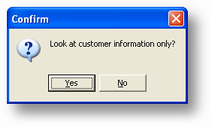
When you first run this program the above dialog screen will allow you to view customer(no record locking) by choosing 'YES' If you answer this 'No' andif you have security level you will be able to edit or ad new customer.(recordlocking) after you make your choice the screen below will be displayed.
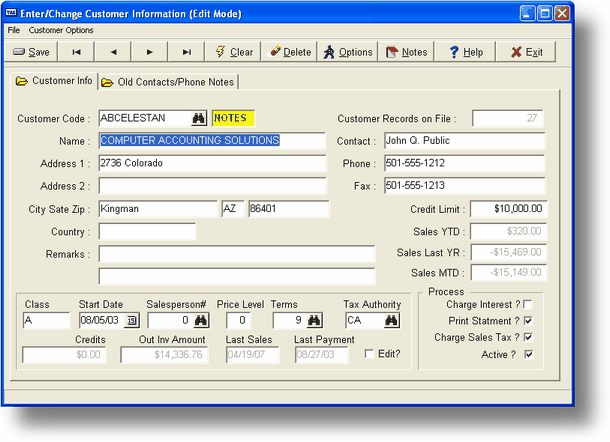
Standard Customer Information
Customer Code (Required)
The Customer Code you assign to identify this record in other parts of Advanced Accounting. This is a 10 character alphanumeric field.
Active?
If the customer has any activity in the
NOTES
If the word NOTES appears to the right of the Customer Code when a record is active (displayed on the screen) then you have notes recorded for this customer. To display them press the Alt-F1 key. For more information please see Advanced Accounting 7 Overview, TASNotes.
Name
The actual customer name.
Add1 - Address Line 1
The first of 2 address lines.
Add2 - Address Line 2
The second of 2 address lines. This can be a second address or simply a suite number.
CSZ - City, State and Zip (Postal) Code
City is a 15 character field, State is the next 2 character field, and Zip or Postal Code is the next 10 character field.
Ctry - Country
If you have customers in multiple countries, enter the country name here.
Contact
The person at your customer's location with whom you normally speak.
Phone and Fax
The telephone and telefax machine (if applicable) number for this customer.
Cr Limit - Credit Limit
The maximum amount this customer is allowed to have outstanding in open invoices. If the customer exceeds this limit during invoice entry, the program will alert you to that situation. You may, however, turn off all checking using SY-A-B, Enter/Change Invoicing Defaults.
Sls YTD - Sales Year to date
This is the total gross sales for this customer during the current calendar year.
LYR - Sales Last Year
The gross sales for this customer for the previous calendar year.
Rmks - Remarks
These two lines will be displayed during sales order entry (SO-A) after the customer is chosen but before any other information is entered. You can use these lines as a reminder of important information that you want everyone to see before entering an order for this customer. This might be credit hold, special deals, etc.
Class - Customer Classification
This is a 2 character alphanumeric field used as an additional means of grouping customers for reports. For example, you might want to group all of your charge customers, or all of your customers who are resellers, into a single report. Use this field to designate such a group.
Start
A standard date; the date of the first sale to the customer or when they were entered into the system.
Slsp - Salesperson
The employee code of the salesperson who is handling this customer account. You must already have designated your commission employees in PR-H, Enter Salespeople before making an entry here.
Int? - Charge Interest?
If you want this customer to be charged interest on past due invoices in AR-D, Charge Interest on Inv enter a Y in this field; otherwise enter N.
Stmt? - Print Statement?
Enter Y if this is a customer is to be sent a statement.
Tax? - Are sales to this customer normally taxable?
Enter Y if this customer is normally charged sales tax on transactions; otherwise enter N.
PLvl - Price Level
A number (0-9) indicating the level of discounting you offer to a customer. In Advanced Accounting, this is a flexible way to set up a multi-tiered discount structure. The discount is set up in IC-H, Enter Price Matrix or as a part of the inventory item entry (IC-A). The default entry, level 0, is the base price for the inventory item. See Using a Price Matrix.
Terms - Default Terms number
Enter the terms of payment here, chosen from the terms menu. The payment terms entered here will appear as a default entry when creating vouchers and sales orders.
Tax Auth - Taxing Authority Code
Information on all sales for this customer, taxable and non-taxable, will be saved to this taxing authority record so that you will be able to produce the reports required. You must already have entered at least one tax authority in AR-L, Sales Tax Maintenance before filling in this field.
Crdts - Outstanding Credits
The dollar amount of credits for this customer which have not been applied toward outstanding invoices. If you credit a customer, or enter a prepayment, the amount will be recorded as a line item in the A/R detail to be used in paying outstanding invoices, and is displayed here as a quick reference memo.
Inv - Outstanding Invoice Amts
The dollar amount outstanding in open invoices for this customer. There can be an amount in this field even if the customer also has a credit balance. In that case the credits have not be applied to the outstanding invoices.
Lst Sale - Date of last sale
The date of the last invoice posted for this customer.
Lst Pmt - Date of last payment
The date of the last payment made by this customer.
General Program Operation
Creating a New Customer Record
When the screen is first displayed the cursor is located in the Cust Code field. Enter a new Customer Code and press ENTER. Use codes that will help you identify customers in groups or alphabetical ranges for other operations in Advanced Accounting.
![]() This program will automatically create a Customer Code depending on a choice you make in System Maintenance (SY-A-B). The program will either use the Telephone number (takes all characters other than the numeric ones out first), use a sequential number, or uses a combination of the first 6 characters of the Customer Name, then the State and the first two characters of the City (this is the default and what we use at CAS). To have the system create a code for you just press the ENTER key when you're at the Customer Code (leave it blank). Before you are asked if you wish to save the record the new code will be displayed. If for some reason the code would conflict with one already on file you will be notified and you must change it so that it doesn't.
This program will automatically create a Customer Code depending on a choice you make in System Maintenance (SY-A-B). The program will either use the Telephone number (takes all characters other than the numeric ones out first), use a sequential number, or uses a combination of the first 6 characters of the Customer Name, then the State and the first two characters of the City (this is the default and what we use at CAS). To have the system create a code for you just press the ENTER key when you're at the Customer Code (leave it blank). Before you are asked if you wish to save the record the new code will be displayed. If for some reason the code would conflict with one already on file you will be notified and you must change it so that it doesn't.
You can also set the defaults values for each field in a new customer record by creating a DEFAULT record. For more information about this please refer to Default Records.
If the Code has been previously used the appropriate record will be displayed. To clear the screen so that you can enter another code, press F3.
After you enter the new Customer Code, fill in the rest of the appropriate fields (see Field Explanations above). You can save a record in either of two ways:
| 1. | After you fill in the last field and press ENTER, the program asks whether you want to save the record: |
If you answer Y, the record will be saved and the screen cleared.
If you answer N, the program will return you to the Cust Name field to edit the record. If you use the Up arrow to enter the Cust Code field at this point, any data entered and not saved will be lost.
| 2. | At any time while entering data, you can press F10 and the program asks whether you want to save the record. Your options are the same as in choice 1. |
You must answer Y when asked if you want to save the record before the record will be permanently recorded in the customer file. The program will not allow you to save a record that does not have a customer code.
After saving a record in the customer file the program will also ask if you wish to enter a sale for that customer. If you enter Y the program will chain to the SO-A program. When it is finished you will be returned to this program. This applies to both new and current customers.
Changing an Existing Customer Record
If you need to change a customer address or telephone number, or if some other important information has changed, find the existing customer record by performing one of the following operations:
| 1. | Enter the full customer code at the Cust Code field and press ENTER. |
| 2. | Use the standard record search keys to search for the code. For a list of these keys and their functions see the explanation in Standard Key Functions. |
| 3. | Use the list display option to choose from a list of customers. Press F2 to display the list of existing customers, then proceed as explained in Getting Around in Advanced Accounting. |
Once the customer record is displayed, you may change any of the fields above the single line. You will not be able to change Crdts, Inv, Lst Sale or Lst Pmt. Save the changes as described in Creating a New Customer Record above.
![]() To change a Customer Code please refer to SY-M, Change Related Rec Vals.
To change a Customer Code please refer to SY-M, Change Related Rec Vals.
Deleting an Existing Customer Record
When you delete a customer record, the Outstanding Inv Amt and Outstanding Credit Amt balances for the customer must show a $0.00 balance. Find the appropriate record as in the change process above. Press the F4 key. The program will ask you to verify the delete request. Once it is deleted the record cannot be recovered. You will have to reenter the customer if it is deleted in error. When a customer is deleted the program also deletes any additional address, contact and credit card records.
Other Customer Options
Using this same program you may get other information about this customer and enter additional addresses, contacts and credit card info that can be used during sales order entry. If you click the options button the following menu will be displayed:
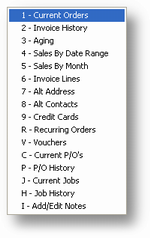 |
| 1. | Current Orders - This option will show a list of all current (open) Sales Orders. This is a sliding list and you can see more of the record by pressing the RIGHT ARROW key. You can see the entire order by moving the cursor bar to the appropriate line and pressing the ENTER key. The program will chain to SO-A and the order will be displayed. If you wish to enter a new order from this list then press the INSERT key. |
Once the sales order is completely invoiced it is automatically deleted from this list. To delete a sales order before invoicing you must first choose it by moving the cursor to the appropriate line and press the ENTER key. When the sales order header is displayed press the F4 key. You will be asked to confirm your action. If you enter Y the entire sales order will be deleted and you will be returned to this list.
| 2. | Invoice History - This will show a listing similar to option 1 above, however, this displays invoices instead of sales orders. To see the entire invoice move the cursor bar to the appropriate line and press the ENTER key. The program will chain to SO-K. You may continue displaying invoices for that customer until you reach the end of their invoice history. |
| 3. | Aging - This option will chain to AR-F and will display the current aging for this customer. |
| 4. | Sales by Date Range - If you choose this option the screen above is displayed. You will be able to enter 4 different date ranges. The program will automatically calculate the total sales amount. The dates you enter are saved and will be used as the defaults the next time you choose this option for any customer. This option uses data in the invoice history file and will only be effective if you have Hist? set to Y for this customer. The results of this option may be printed if desired. |
| 5. | Sales by Month - This option will print the Gross, COGS, Net Sales and Net Margin Percentage by month for this customer. Only those months in which sales were recorded will be displayed. The program will display up to 5 years of sales in descending order (current year first). |
| 6. | Invoice Lines - This option will display only the line items from past invoices. This will let you quickly and easily see the actual items from those invoices without having to scan through each individual invoice as in option 2 above. However, if you choose a specific line item the invoice for that line item will be displayed as in option 2 above. You will be able to limit the display to only the current year and only actual line items will be displayed, no message lines. |
| R. | Recurring Orders - Lists the orders entered in SO-I for this customer. If you choose one of the line items displayed the SO-I program will be run with the appropriate data. |
| V. | Vouchers - Lists open vouchers (entered through AR-B) for this customer. |
| C. | Current P/Os - Lists open purchase orders (entered through PO-A) that have this customer listed as the Ordered For value. If you choose one of the line items displayed the PO-A program will be run with the appropriate data. |
| P. | P/O History - Lists closed purchase orders that have this customer listed as the Ordered For value. |
| J. | Current Jobs - Lists open jobs (entered through JC-A) for this customer. If you choose one of the line items displayed the JC-A program will be run with the appropriate data. |
| H. | Job History - Lists closed jobs for this customer. |
| 7. | Alt Addresses - If this customer has alternate addresses for mailings, shipping, etc., use this option to add, change or delete them. You can choose from among these addresses during sales order entry for either the Sold To or Ship To address. See Alternate Address Maintenance below for more information. |
| 8. | Alt Contacts - If this customer has alternate contacts use this option. See SC-A - Enter/Change Contacts. |
![]() You can easily enter a default contact record for this customer by choosing this option. When the program chains to SC-A, you will be asked if you wish to create a default record. If you enter Yes, the code, name, address and telephone/fax numbers will be transfered from the customer record to the contact record. It is a good idea to have a contact record for each customer if you are going to use the email or fax options in the printing routines since the address/number comes from this record.
You can easily enter a default contact record for this customer by choosing this option. When the program chains to SC-A, you will be asked if you wish to create a default record. If you enter Yes, the code, name, address and telephone/fax numbers will be transfered from the customer record to the contact record. It is a good idea to have a contact record for each customer if you are going to use the email or fax options in the printing routines since the address/number comes from this record.
| 9. | Credit Cards - If this customer charges orders on a credit card you will be able to record their credit card information here. This information is available to you during sales order entry. See Credit Card Maintenance below for more information. |
Alternate Address Maintenance
Use this to keep additional addresses for this customer. These addresses can be used in sales order entry for either the Sold To or Ship To address. When you choose this option the following list box is displayed (if you have not entered any alternate addresses previously then the list is empty):
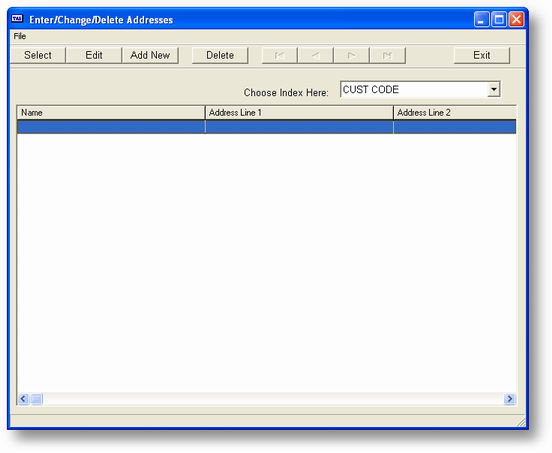
To enter a new alternate address press the INSERT key or the add new button and the following screen will be displayed:
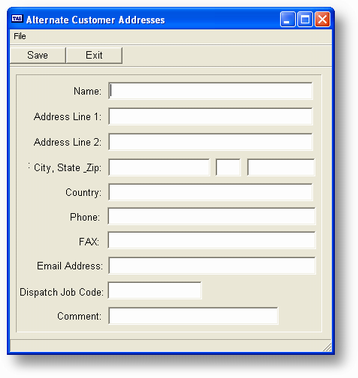
You will then be able to add a new address for this customer. All field sizes are the same as for the original company name and address lines. You can also indicate how and when this address is to be used. Press ENTER after the last field or F10 to save the new address.
To modify an Alternate Address move the cursor to the appropriate line and press the ENTER key. The entry window above will be displayed, this time with the current data. Press ENTER after the last field or F10 to save any changes.
To delete an Alternate Address move the cursor to the appropriate line and press the DELETE key. The program will ask you to confirm your action. If you enter Y or click on the Yes button the address will be deleted from the list.
Credit Card Maintenance
Use this to keep a list of credit card numbers for this customer. You will be able to select a credit card from this list during sales order entry and have the charge card information print out on the resulting invoice. When you choose this option the following list box is displayed (if you have not entered any credit cards previously then the list is empty):
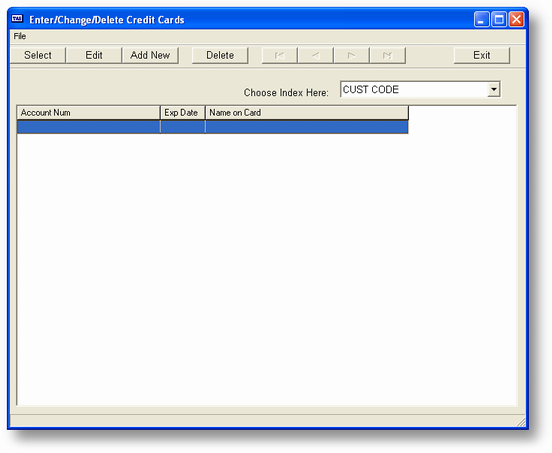
To enter a new credit card press the INSERT key or click the add new button and the following screen will be displayed:
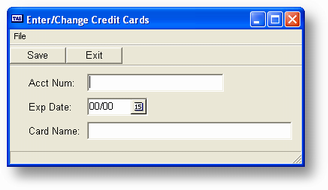
You can then enter the credit card account number, expiration date and account name. Press ENTER after the last field or F10 to save this information.
To modify credit card information move the cursor to the appropriate line and press the ENTER key. The entry window above will be displayed, this time with the current data. Press ENTER after the last field or F10 to save any changes.
To delete a credit card move the cursor to the appropriate line and press the DELETE key. The program will ask you to confirm your action. If you enter Y the credit card will be deleted from the list.
Page url: http://www.cassoftware.com.com/adv7docs/index.html?a_enterchangecustomers.htm